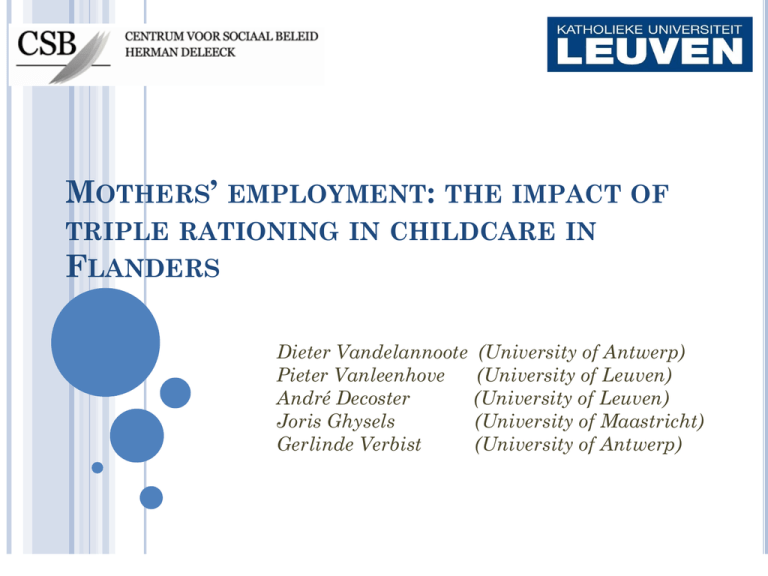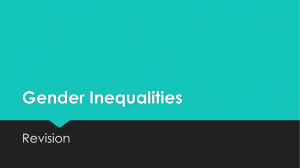Labour supply and child care in a discrete choice model
advertisement

MOTHERS’
EMPLOYMENT: THE IMPACT OF
TRIPLE RATIONING IN CHILDCARE IN
FLANDERS
Dieter Vandelannoote
Pieter Vanleenhove
André Decoster
Joris Ghysels
Gerlinde Verbist
(University of Antwerp)
(University of Leuven)
(University of Leuven)
(University of Maastricht)
(University of Antwerp)
OVERVIEW
Literature on employment and childcare
Childcare in Flanders: triple rationing
Labour supply model
Results
Conclusions
LITERATURE
-
-
Childcare touches upon
Budget constraints of parents
Preferences of parents
Modelling preferences for childcare is
demanding
Disentangle preferences from rationing
Identify heterogeneity in preferences
Often strong assumptions are made (e.g. Wrohlich, 2011,
assumes market supply to cover all excess demand in
Germany)
LITERATURE
Budget constraint approaches
-
Cost of working model (vs. simultaneous model)
-
In other words: it assumes childcare services to cover for
parental working time
-
With individually observed rationing (e.g. Kornstad and
Thoresen, 2007): individual choice sets are constructed
-
Without individually observed rationing (e.g. Del Boca and
Vuri, 2005): choice set is limited based on a simulated offer
probability of formal childcare
CHILDCARE IN FLANDERS: TRIPLE
RATIONING
-
-
Pre-primary education is generalised from
age 3
For children younger than 3:
Formal childcare (↗):
Supervision by Child and Family
Subsidized (59%) vs non subsidized (41%)
Child-minders vs day nurseries
Informal childcare (↘):
Mainly grandparents
CHILDCARE IN FLANDERS: TRIPLE
RATIONING
Although 70% of children younger than 3 is regular
user of formal childcare in 2005
Although 76% of mothers of children younger than 3
were gainfully employed in 2005
There are strong indications of preference
heterogeneity and rationing in Flanders:
-
When asked what kind of service they would prefer to use, parents often
indicate another type of childcare than the one used
A 2007 survey indicated that 10% of the parents was not able to secure a
suitable childcare service for their child after 6 months of searching
Supply grows only slowly
In our 2005 survey, 70% of non-employed mothers (unemployed or
inactive) indicated they would be willing to work, if suitable childcare
were available
CHILDCARE IN FLANDERS: TRIPLE
RATIONING
Costs for parents vary greatly according to the
type of service:
-
Informal childcare: free
-
Formal subsidized childcare: income dependent price scheme
(1,25 – 22 euro per day, before tax deduction, 2005)
-
Formal non subsidized childcare: suppliers can set prices
freely (average of 18 euro per day, before tax deduction, 2005)
-
We assume parents to act in a stepwise fashion:
informal → formal subsidized → formal non subsidized
LABOUR SUPPLY MODEL
Random utility model with discrete budget
constraint:
-
Random utility model: Vi , j U i ((T hi , j ), Ci , j | X i ) i , j
-
Discrete budget constraints:
-
Calculate household budget for every alternative, taking into
account:
1. wage (expected)
2. household characteristics Xi
3. tax-benefit rules
4. expected cost of childcare
= {0, 20, 32, 40}
LABOUR SUPPLY MODEL
Relies for estimation on McFadden’s (1974)
multinomial logit model:
Requires a specification for the utility function.
We use a quadratic form:
U i ((T hi , j ), Ci , j | X i ) c .[Ci , j ] cc .[Ci , j ]2
f ( X i ).[T hi , j ] ff .[T hi , j ]2
fc .[T hi , j ].[Ci , j ]
LABOUR SUPPLY MODEL + RATIONING
IN CHILDCARE SECTOR (1)
Double-hurdle model (as in Bargain et al, 2006)
assuming the likelihood of an offer (i.e. total rationing
to be equal across various labour market intensities
))
LABOUR SUPPLY MODEL + RATIONING
IN CHILDCARE SECTOR (2)
In the budget constraints, we incorporate
the expected cost of childcare:
E[cost hj] = [p(informal care offer) * 0] +
[(1- p(informal care offer) * p(subsidized care offer) *
cost(subsidized care hj)] +
[1- p( subsidized care offer) * p(non subsidized care
offer) * cost(non subsidized care hj)]
LABOUR SUPPLY MODEL
-
Effective offer of childcare derives from a
bivariate binary process:
Effective offer (0/1) = effective demand (0/1) * effective
supply (0/1)
We use a partial observability probit model
to estimate three probabilities in sequential
order (Poirier, 1980)
LABOUR SUPPLY MODEL
-
-
-
Informal care (grandparents):
supply: number, health status, employment status,
distance
demand: preference indicator of both mother and father
Formal subsidized childcare:
supply: municipal structure, search skills of the parents
demand: preferences indicators + likelihood of an offer in
informal care
Formal non subsidized childcare:
supply: municipal structure, search skills of the parents
demand: preferences indicators + likelihood of an offer in
both informal care and subsidized childcare
LABOUR SUPPLY MODEL
Predicted probability
(mean values)
Grandparents
.34
Subsidized care
.79
Non-subsidized care
.51
Total
.94
LABOUR SUPPLY MODEL
-
Estimate budget constraints using Euromod
Use data of the 2005 FFCS (Flanders
Families and Care survey). We focus on:
Couple families
With a child between 6 and 35 months
Both partners available for the labour market
No self employed
No handicapped child
Male partner working in a fulltime job (>90%)
512 couples
RESULTS
Maximum likelihood
estimates of the
parameters of the
quadratic utility
function
Statistically highly
significant
bc
bcc
Std.
Coefficient Error
P-value
22.80
3.94 .000
-1.82
0.34 .000
bf
Age
Age squared
Children 0-3
Children 4-6
Children 7-9
Higher education
Constant
-0.03
0.00
0.04
0.05
0.03
-0.02
1.27
0.01
0.00
0.01
0.01
0.01
0.01
0.25
.015
.008
.001
.000
.018
.069
.000
bff
bfc
-0.00
-0.09
0.00
0.02
.000
.000
RESULTS
Reflects inclination of
indifference curve at
(C = 2000 and h = 40)
Different subgroups
“How much income do
I want to give up for
one hour of additional
non-working time?”
Subgroup
MRS
(euro)
Whole sample
-30.3
No university
-31.4
University degree
-29.7
One child 0-3
-30.0
Two children 0-3
-31.4
Three children 03
-36.8
RESULTS
% LFP
% change in
total working
hours
Base
82.4
Increase gross wage +10%
83.2
+2.5
Increase childcare cost +10%
82.2
-0.7
Make childcare cost = 0
83.8
+5.8
Take away rationing
(i.e. make actual = desired
working hours)
95.3
+14.3
CONCLUSIONS
-
-
We extend the discrete labour supply model
with:
Overall childcare service rationing
Variation in the cost of childcare services depending on the
likelihood of informal, formal subsidized and formal non
subsidized childcare
Results indicate that in the current Flemish
situation
Prices are not of paramount influence
Childcare rationing withholds a considerable number of
mothers from the labour market






